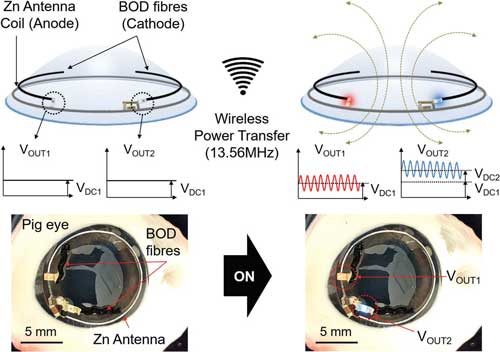| Feb 18, 2020 | |
Power sources for smart contact lenses(Nanowerk News) Smart contact lenses are being developed as health monitoring biosensors, wearable electronics and virtual or augmented reality displays. |
|
| Constructing power sources on these types of contact lenses is challenging because the power device must be mounted on the restricted area of the lens without obstructing the vision. | |
| Power-generation devices for electrical contact lenses are classified into three types: 1) metal–air primary batteries using biodegradable metallic electrodes; 2) enzymatic biofuel cells (BFCs) harvesting the power from tear biofuels such as glucose and lactate; and 3) wireless power transfer (WPT) systems placed between the transmitter and receiver on the lens. | |
| WPT systems wirelessly transfer both power and information to a lens device. Although requiring an external power source for their transmitters, WPT system can modulate the input power to the lens devices by changing the power transfer from the transmitter. | |
| Reporting their findings in Advanced Functional Materials ("Multifunctional High-Power Sources for Smart Contact Lenses"), researchers have demonstrated a multifunctional AC and/or DC power supply on soft, moist contact lenses. The proposed system combines a WPT AC system with a metallic-air DC battery. | |
 |
|
| Hybrid power sources composed of a wireless power transfer system and a Zn–air battery. The Zn loop coils were used as both the wireless antennae and the electrochemical anode for the battery. The metallic anodes were connected to a bilirubin oxidase (BOD) biocathode, generating a DC offset (VDC1) in the tear electrolyte. The Zn loop antenna (inductance L) in parallel with the capacitor C received an alternating current (AC) power on the lens receiver; the corresponding voltage is VAC. The lens receiver was integrated with a half-wave rectifier circuit to generate the capacitive voltage VDC2. The output was evaluated at both ports: Port 1 (VOUT1) between the LC resonator and the BOD cathode, and Port 2 (VOUT2) through the rectifier circuit. Without the AC supply, both output voltages VOUT1 and VOUT2 equaled VDC1. When an AC voltage at 13.56 MHz was applied to the transmitter, the output voltage VOUT1 increased to VAC + VDC1, while VOUT2 increased further to VAC + VDC1 + VDC2. These enhanced voltages illuminated the red and blue LEDs on the lens, respectively. (Reprinted with permission by Wiley-VCH Verlag) (click on image to enlarge) | |
| For their experiments, the researchers applied a series of multifunctional, high-power sources to a moist, soft contact lens. During the operation, they observed no pH changes or bubbles in the artificial tear electrolyte. | |
| The team concludes that their hybrid power source can potentially realize wearable electronics in body fluids, and promises versatile sources for many applications such as displays and iontophoretic drug-delivery systems. |
 By
Michael
Berger
– Michael is author of three books by the Royal Society of Chemistry:
Nano-Society: Pushing the Boundaries of Technology,
Nanotechnology: The Future is Tiny, and
Nanoengineering: The Skills and Tools Making Technology Invisible
Copyright ©
Nanowerk LLC
By
Michael
Berger
– Michael is author of three books by the Royal Society of Chemistry:
Nano-Society: Pushing the Boundaries of Technology,
Nanotechnology: The Future is Tiny, and
Nanoengineering: The Skills and Tools Making Technology Invisible
Copyright ©
Nanowerk LLC
|
|
|
Subscribe to a free copy of one of our daily Nanowerk Newsletter Email Digests with a compilation of all of the day's news. |
